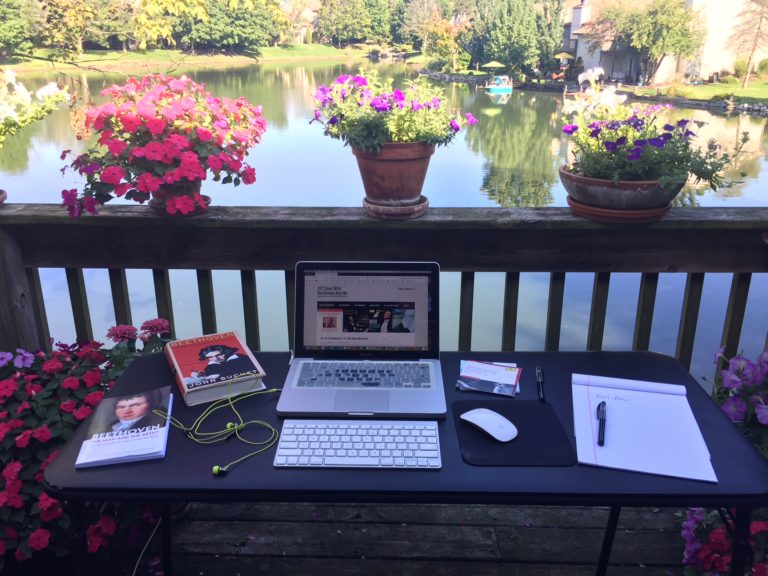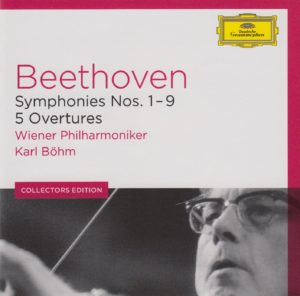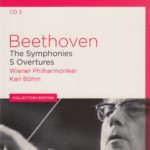
My office this morning, once again, overlooks the small lake behind our residence. It’s a bit chilly this morning (65 degrees Fahrenheit) under partly cloudy skies. So, unlike on previous mornings, I had to wear what I call a “shammy,” which is in this case an oversized, button-down flannel shirt I purchased from Cabela’s.
Don’t ask me why I call this kind of shirt a shammy. Somewhere along the way, my wife and I started calling it that, and now we often say, “This is shammy weather” or something along those lines. We said it this morning on the way to the car, in fact. I wear shammies constantly in the Spring and Fall, sometimes into the Winter. They’re like a thin jacket.
Anyway, I want to start with a quote from John Suchet’s book, Beethoven: The Man Revealed (pages 147, 148),
He had begun work on a new symphony, his Third. It was a symphony that would, quite simply, set music on a new course. It is a cliche, and usually an exaggeration, to say any one thing changed the course of any other thing. In this case it is true. Beethoven’s Third Symphony changed the course of music. We are talking here about the ‘Eroica.’
As always with Beethoven, ideas began with fragmentary sketches and jottings, but it seems he composed the ‘Eroica’ in an intensive three-month period in the summer of 1803. This is all the more remarkable in that the work is longer, and more complex, than any symphony hitherto written by anybody. The first movement alone runs to almost 700 bars, anything between fifteen and twenty minutes in performance.
Beethoven himself was in no doubt he had composed something out of the ordinary, nor were those close to him.
It’s because of books like Suchet’s and short video discussions about Beethoven (from Leonard Bernstein) that I undertake these musical projects. I love to learn. And I would not likely have been forced to read books about Beethoven, nor discover the music and charismatic personality of Leonard Bernstein, if not for these occasional projects.
When I started listening to Beethoven’s Third a few days ago, I was remarkably unimpressed with it. In fact, it bored me to tears.
However, after watching the Bernstein video and reading books from Suchet and others, I realize what a monumental work this is. And, accordingly, my appreciation for it increased. It’s still not my favorite.
 But my opinion of it is different now from what it was when I started listening to it on Day 37.
But my opinion of it is different now from what it was when I started listening to it on Day 37.
Officially, this morning (a bright, slightly cool day in late August), I am listening to Beethoven’s Symphony No. 3 in E flat Major, the Wiener Philharmoniker (Vienna Philharmonic) is the orchestra.
The late Austrian conductor Karl Bohm (1894-1981) wields the baton.
I first encountered Bohm on Day 5 and then again on Day 23.
What do I think of Bohm’s interpretation of Beethoven’s Third?
I can tell you this much: even with the chill in the air and constant interruption from having to shoo away flies (the hell are they doing out here in such force, anyway?), I am enjoying what I’m hearing. Very much so.
 Beethoven wrote his symphonies in four parts (except for the Sixth, which is in five). The time breakdown of this particular one (Symphony No. 3 in E flat Major), from this particular conductor (Bohm, at age 76) and this particular orchestra (Wiener Philharmoniker), at this particular time in history (April, 1970) on this particular record label (Deutsche Grammophon) is as follows:
Beethoven wrote his symphonies in four parts (except for the Sixth, which is in five). The time breakdown of this particular one (Symphony No. 3 in E flat Major), from this particular conductor (Bohm, at age 76) and this particular orchestra (Wiener Philharmoniker), at this particular time in history (April, 1970) on this particular record label (Deutsche Grammophon) is as follows:
I. Allegro con brio………………………………………………………………………14:56
II. Marcia funebre: Adagio assai……………………………………………….16:18
III. Scherzo: Allegro vivace – Trio…………………………………………………6:06
IV. Finale: Allegro molto – Poco andante – Presto…………………..12:35
Total running time: 49:15
My Rating:
Recording quality: 5 (hardly any noticeable tape hiss at times; crystal clear, totally up to high DG standards)
Overall musicianship: 5 (lots of energy)
CD liner notes: 3 (short essay about Beethoven, lyrics in French, German, English, but nothing about Bohm or the Vienna Philharmonic Orchestra)
How does this make me feel: 5
This is a spectacular, spirited performance. I especially enjoyed the opening movement, Allegro con brio (love the French horns around the 8:50 mark), and the closing movement, the Finale.
This is a fine recording of an inspired performance. I can hear every instrument, and I feel the passion of the performers. They were into this one.
I can’t help but award this with a rousing…
“Huzzah!”
